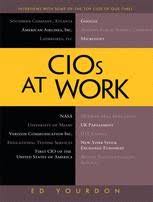This white paper examines the critical role of the Chief Information Officer (CIO) in navigating the digital transformation of organizations in the 21st century. Drawing from insights presented in "CIO at Work" by Apress and supplementary industry research, the document explores strategic leadership, technology adoption, cybersecurity, team management, and future trends. Recommendations and case studies are included to provide actionable insights for CIOs aspiring to lead their organizations through technological disruptions.
White Paper: The Evolving Role of the CIO in Driving Digital Transformation
Abstract
This white paper examines the critical role of the Chief Information Officer (CIO) in navigating the digital transformation of organizations in the 21st century. Drawing from insights presented in "CIO at Work" by Apress and supplementary industry research, the document explores strategic leadership, technology adoption, cybersecurity, team management, and future trends. Recommendations and case studies are included to provide actionable insights for CIOs aspiring to lead their organizations through technological disruptions.
1. Introduction
The modern CIO occupies a pivotal position in organizations, transforming IT from a support function into a strategic driver of business innovation. In an era of rapid technological advancements, CIOs must act as visionaries, strategists, and change agents to harness the power of emerging technologies. This paper outlines the competencies required, challenges faced, and strategies employed by CIOs to stay ahead in the digital landscape.
2. The Strategic Role of the CIO
2.1. From Operational to Strategic Leadership
CIOs have evolved from IT managers to business leaders responsible for aligning technology with organizational goals. They bridge the gap between technical teams and executive leadership, ensuring that IT investments deliver measurable business value.
2.2. Aligning IT with Business Goals
CIOs must ensure that IT strategies are fully integrated with organizational objectives, including cost optimization, revenue growth, and customer satisfaction. Collaborative frameworks, such as OKRs (Objectives and Key Results), are increasingly employed to achieve alignment.
3. Technology Adoption and Innovation
3.1. Emerging Technologies
Key technologies reshaping businesses include:
- Artificial Intelligence (AI) and Machine Learning (ML): Enabling predictive analytics, automation, and personalized customer experiences.
- Cloud Computing: Offering scalability, flexibility, and cost savings.
- Blockchain: Enhancing security and transparency in supply chain and financial operations.
- Internet of Things (IoT): Providing actionable data insights through interconnected devices.
3.2. Fostering a Culture of Innovation
CIOs must encourage experimentation and innovation by:
- Establishing innovation labs.
- Promoting agile methodologies.
- Partnering with startups and technology providers.
4. Cybersecurity and Risk Management
4.1. Balancing Innovation with Security
CIOs must address cybersecurity challenges without stifling innovation. Key areas of focus include:
- Implementing zero-trust security models.
- Conducting regular penetration testing and audits.
- Training employees on cybersecurity best practices.
4.2. Regulatory Compliance
Adherence to regulations like GDPR (General Data Protection Regulation) and CCPA (California Consumer Privacy Act) is critical to mitigate legal risks and protect organizational reputation.
5. Team and Talent Management
5.1. Building High-Performing Teams
CIOs must cultivate a diverse and skilled workforce by:
- Recruiting talent with expertise in emerging technologies.
- Offering continuous learning opportunities.
- Creating inclusive environments to foster collaboration.
5.2. Managing Remote and Hybrid Teams
The shift to hybrid work models necessitates tools and policies to maintain productivity, communication, and morale.
6. Challenges in Digital Transformation
6.1. Organizational Resistance
Change management is a significant challenge for CIOs. Strategies to overcome resistance include:
- Transparent communication of the transformation’s benefits.
- Involving stakeholders at every stage of the process.
- Demonstrating quick wins to build momentum.
6.2. Budget Constraints
CIOs must prioritize IT investments that deliver the highest ROI and secure executive buy-in by presenting data-driven business cases.
7. Future Trends in IT Leadership
7.1. The Rise of Data-Driven Decision-Making
CIOs are leveraging big data and advanced analytics to inform business decisions, optimize operations, and predict market trends.
7.2. Focus on Sustainability
IT leaders are adopting green computing practices and energy-efficient technologies to support organizational sustainability goals.
7.3. Preparing for Disruptive Technologies
Anticipating and planning for disruptions, such as quantum computing and advanced robotics, will be critical to maintaining a competitive edge.
8. Case Studies
8.1. Company A: Driving Growth Through AI
A global retailer leveraged AI-driven demand forecasting, implemented by its CIO, to reduce inventory costs by 20% while improving customer satisfaction.
8.2. Company B: Cloud Transformation
A financial services firm successfully migrated to a hybrid cloud environment under the CIO’s leadership, achieving a 30% reduction in IT infrastructure costs.
8.3. Company C: Cybersecurity Overhaul
An e-commerce platform’s CIO introduced a zero-trust model and real-time threat detection, reducing security breaches by 50% within two years.
9. Recommendations
- Develop a Long-Term IT Strategy: Align IT initiatives with overarching business objectives.
- Invest in Talent: Build a workforce skilled in cutting-edge technologies.
- Foster Cross-Department Collaboration: Break down silos to drive innovation.
- Embrace a Customer-Centric Approach: Leverage technology to enhance user experiences.
- Adopt Agile Practices: Enable faster delivery of IT projects.
- Focus on Security and Compliance: Proactively address cybersecurity risks and regulatory requirements.
10. Conclusion
The CIO’s role is more critical than ever in today’s rapidly evolving digital landscape. By adopting strategic leadership, fostering innovation, and navigating challenges effectively, CIOs can position their organizations for long-term success.
References
- Apress. CIO at Work. Apress Media.
- Gartner. “Top Strategic Technology Trends for 2025.”
- McKinsey & Company. “Digital Transformation: The Role of CIOs.”
- Harvard Business Review. “The Evolving Role of the CIO.”
- Forbes. “CIOs as Change Agents in the Digital Era.”
